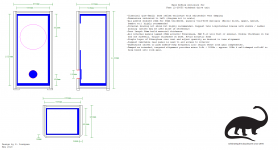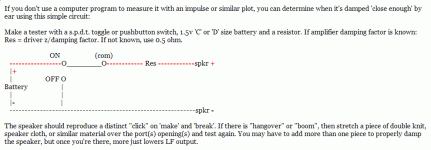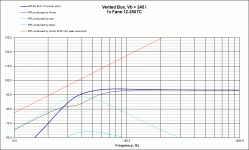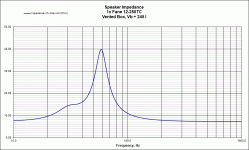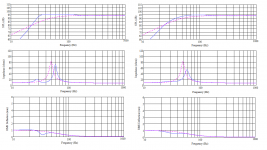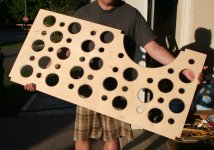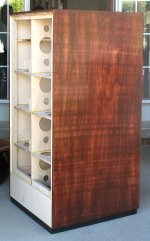I've worked up a large (in terms of what many would call 'large', rather than acoustically) bass reflex design for it; F6 = 38Hz as it's a fairly well-damped rolloff to make it reasonably flexible in terms of room positioning. Down side is, as noted, it's not small, though not ridiculous either. I haven't had chance to draw it up, or get Dave to do so yet though; if you want me to do so though, I'll try. That said, given the amount of abuse I'm getting in another quarter, I'm starting to wonder whether any of this is worth the effort.
It's definitely worth the effort Scott. These really are superb drivers and are well worth working with.
Yes, please post it. I'm listening to the 15" version in mono in a PA cabinet right now, but would love a pair of the 12s for movies/music.
Fair enough. I suppose I should list a few caveats / points to keep in mind though.
-These are physically large by most current standards, and fairly high output, or would be sans damping.
-In design terms they're derived from a traditional bass reflex, as opposed to a Small type vented box. So they're treated and tuned in that way. There are some notes in the png file.
-The box tuning and alignment has some flexibility. One method of tuning pre-Small (strictly, pre-Novak) bass reflex enclosures, which I've used here, was to staple damping material over the vent, once the basic box Fb was sorted. The design as-is assumes a layer of damping stapled over the vent. Adjust that & the internal damping to preference. Since this is a traditional box, keep it simple & use the click test (attached). Minor note there: the click test is largely to determine overhang rather than output. Here we have the option (likely need in many cases) to reduce enclosure output also, so keep in mind.
-If you put enough damping over the vent, you'll end up quasi-aperiodic. Not what I intended, but if that's what you like, great. If you want to do without, that's also fine (obviously), but the LF output will probably overpower both midband and room. It can be sealed completely as an extreme measure if desired, which will give a Q around Butterworth. One point about vent damping -fixing whatever is used in place is advisible or it will tend to beat against the duct.
-Cosmetic additions e.g. end & top caps are fine. Same goes for feet.
-This is the world's worst drawing. I have zero CAD skills & can't inflict everything on Dave, so I'm stuck with Windows Paint. Sorry.
-I've added anechoic plots from a couple of different pieces of software, but there is some variability between different software assumptions when it comes to damping, & since adjustability is part & parcel, it's a bit of a moot point per se. They give a rough idea though. I didn't include Le as it doesn't affect the behaviour of this design.
-I don't make any promises that anybody will like it.
-These are physically large by most current standards, and fairly high output, or would be sans damping.
-In design terms they're derived from a traditional bass reflex, as opposed to a Small type vented box. So they're treated and tuned in that way. There are some notes in the png file.
-The box tuning and alignment has some flexibility. One method of tuning pre-Small (strictly, pre-Novak) bass reflex enclosures, which I've used here, was to staple damping material over the vent, once the basic box Fb was sorted. The design as-is assumes a layer of damping stapled over the vent. Adjust that & the internal damping to preference. Since this is a traditional box, keep it simple & use the click test (attached). Minor note there: the click test is largely to determine overhang rather than output. Here we have the option (likely need in many cases) to reduce enclosure output also, so keep in mind.
-If you put enough damping over the vent, you'll end up quasi-aperiodic. Not what I intended, but if that's what you like, great. If you want to do without, that's also fine (obviously), but the LF output will probably overpower both midband and room. It can be sealed completely as an extreme measure if desired, which will give a Q around Butterworth. One point about vent damping -fixing whatever is used in place is advisible or it will tend to beat against the duct.
-Cosmetic additions e.g. end & top caps are fine. Same goes for feet.
-This is the world's worst drawing. I have zero CAD skills & can't inflict everything on Dave, so I'm stuck with Windows Paint. Sorry.
-I've added anechoic plots from a couple of different pieces of software, but there is some variability between different software assumptions when it comes to damping, & since adjustability is part & parcel, it's a bit of a moot point per se. They give a rough idea though. I didn't include Le as it doesn't affect the behaviour of this design.
-I don't make any promises that anybody will like it.
Attachments
Last edited:
You're a better drawer than me Scott.
That looks like a proper speaker!
I have a similar sized sealed cab planned for the 15 inchers I have.
Was going to do corner cabs as you know, but after putting my existing 12 inch Fanes in my room corners, playing a bass heavy track and going into the next door neighbor's house, bass could clearly be heard through the party wall; not good, so for the sake of the neighbors, I'm going to have to ditch the corner cab idea and just make a conventional 1960s sized sealed box for the 15s. 🙂
That looks like a proper speaker!
I have a similar sized sealed cab planned for the 15 inchers I have.
Was going to do corner cabs as you know, but after putting my existing 12 inch Fanes in my room corners, playing a bass heavy track and going into the next door neighbor's house, bass could clearly be heard through the party wall; not good, so for the sake of the neighbors, I'm going to have to ditch the corner cab idea and just make a conventional 1960s sized sealed box for the 15s. 🙂
Today the forum, tomorrow Tate Modern... 😀
FWIW Steve... http://www.diyaudio.com/forums/full...io-fostex-tb-dayton-seas-etc.html#post5446631
Aye, that's sometimes the problem of building into the room itself. On the up-side, it's easier to move or tweak speakers that aren't part of the room construction. 😉 1960s sealed box? Works for me. 🙂
FWIW Steve... http://www.diyaudio.com/forums/full...io-fostex-tb-dayton-seas-etc.html#post5446631
Aye, that's sometimes the problem of building into the room itself. On the up-side, it's easier to move or tweak speakers that aren't part of the room construction. 😉 1960s sealed box? Works for me. 🙂
Last edited:
Small it isn't, I admit. And long may it remain so. 😉 Classic US style large sealed.
Back on this, undamped response in left column, damped in right. I could keep posting lots of different plots, but this should probably be sufficient. Ran out of time to edit my post to add them, so putting them here.
Back on this, undamped response in left column, damped in right. I could keep posting lots of different plots, but this should probably be sufficient. Ran out of time to edit my post to add them, so putting them here.
Attachments
Last edited:
Member
Joined 2009
Paid Member
If more is good, too much is just right. 😉
As noted in the png, twin longitudinals are suggested combined with ladder / window braces. TBH, this isn't all that big a box though -it's medium sized Altec / RCA / Tannoy at best.
As noted in the png, twin longitudinals are suggested combined with ladder / window braces. TBH, this isn't all that big a box though -it's medium sized Altec / RCA / Tannoy at best.
Hello,
REally thank you for this plan !!
Damm So large ... 🙁 Impossible for me 🙁 Can I try to deal the larger by the height ?
Bigun : Impressive works !
REally thank you for this plan !!
Damm So large ... 🙁 Impossible for me 🙁 Can I try to deal the larger by the height ?
Bigun : Impressive works !
These are physically large by most current standards, and fairly high output, or would be sans damping.
Indeed, even a little bigger than my [huge] ~223 L 38 Hz MLTL: Need help designing "tapped spiral TL" for Fane 12-250TC
GM
I had my 12-250TC briefly in GregB's Karlsonator12 - but didn't take any measurements to see how much peaking may have been happening on the low end. It did play some hip hop bass drops. Tuning on that cabinet is ~37Hz. Those reflex look pretty good.
If more is good, too much is just right. 😉
As noted in the png, twin longitudinals are suggested combined with ladder / window braces. TBH, this isn't all that big a box though -it's medium sized Altec / RCA / Tannoy at best.
Thx for the design Scott!
Could I get away with a single 24mm or 30mm thickness instead of 2x18mm for the panels?
Last edited:
Indeed, even a little bigger than my [huge] ~223 L 38 Hz MLTL: Need help designing "tapped spiral TL" for Fane 12-250TC
I like it. Yes indeed, I like that very much. 🙂
Hello,
REally thank you for this plan !!
Damm So large ... 🙁 Impossible for me 🙁 Can I try to deal the larger by the height ?
Not significantly. But you could use GM's MLTL linked to above, which is tall & with a smaller cross section. Doesn't really need any duct damping either as the pipe loading helps with that.
Thx for the design Scott!
Could I get away with a single 24mm or 30mm thickness instead of 2x18mm for the panels?
Sure, just make sure there's a decent amount of internal bracing.
- Home
- Loudspeakers
- Full Range
- New 12" Full-Range: Fane 12-250TC
